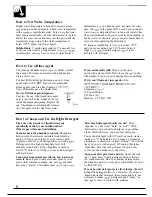
Cycle Selection Hints
It is important to follow the Loading instructions.
●
POTS & PANS—For items such as pots,
●
WATER SAVER—For dishes with
soils that
cookware, dishes
glasses with heavy soil.
have not dried on, or that have extra preparation
Everyday dishes may be included.
before loading. It saves water and energy.
●
NORMAL WASH—For loads everyday dishes,
●
RINSE & HOLD—For rinsing partial loads which
glasses and cookware with medium
Designed
be washed later.
to yield high performance on normal soils.
this
What Happens in Each Cycle
●
You’11 hear occasional c1
sounds:
●
During the drying period:
—Soft food disposer shredding action.
—The motor stops.
—Drain valve opening to pump water out.
— Water vapor comes through the vent by the
—Timer control as cycle progresses.
—Detergent cup opening.
door latch during drying
when water is
being pumped out.
Gallons
Minutes
Wash
)
Sequence
POTS &
PANS
NORMAL WASH
11.4
SAVER
RINSE &
10
*Unextended
These
will be
Drying Options:
DRYING HEAT ON. Available
except RINSE & HOLD.
29
cycle
DRYING HEAT OFF. Drying
is
Dishes
Good
with HOT water
To get dishes clean and dry you need hot water. To
you get water of the proper temperature,
your dishwasher has a WATER HEAT feature that automatically senses the temperature of the water
in the wash cycle
heats it, necessary, to the proper temperature. This water heating feature may allow
you to turn down your household water heater and save energy if you’re willing to let the dishwasher run a little
it
water to the proper temperature. For
and
the entering water must be at
least
To prevent dish damage, inlet water should not exceed
5






































